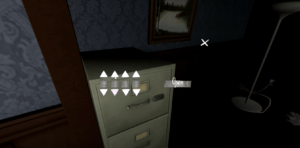For this critical play, I will discuss Gone Home, an interactive exploration simulator game developed by The Fullbright Company. It is available on Microsoft Windows, OS X, Linux, PlayStation 4, Xbox One, Nintendo Switch, and iOS. Given the eerie vibes and the themes that the narrative addresses, the target audience is probably teen players and older.
Important Formal Elements
Gone Home is a single player game, and you play as Katie, an older sister who returns to an empty home after a year abroad in Europe. The objective of the game is to explore and uncover the mystery of what happened to her family members. To solve this mystery, you have or find access to different resources around the house, which are objects including letters and notes, and safes and maps.
Mechanics, mystery, narrative, and type of fun
The mechanics of this mystery game definitely offered a very eerie atmosphere that evoked anticipation and creepiness. The visuals of the game certainly matched the images of the classic “haunted home” – colors were dark and tinted and there existed brief sources of light amidst the darkness. Sound also contributed to the eerie atmosphere – the floor creaked and loud thunder boomed outside. Lastly, the first-person field of sight made it feel like you were actually walking through and exploring the house, allowing for many moments of anticipation for something scary to happen.
The entire mystery and exploration revolves around the story of Katie and her family, and your goal is to unpack this story; two major types of fun in this game are definitely Narrative and Discovery, and they work together. As you explore the house, you gather clues to help construct your picture of the house and family. You read letters and notes that are left behind by family members to learn more about their family history and what had been going on. You find keys and combinations to unlock safes or discover new maps in order to access additional places in the house (i.e. new rooms, drawers and lockers, secret passages, etc.). A first win was unlocking the first combination key after a good amount of time interacting with many seemingly-irrelevant household objects.

These mechanics and puzzles made the piecing together of the narrative a discovery process for a player. Gradually, I uncovered Sam and Lonnie’s developing romantic relationship and the negative reaction by their parents, who were going through issues with their own relationship, and subsequently Sam’s pain and struggle with the latter.
One personal preference for games is a sense of threat or pressure. This game was definitely very exploratory, so I went through the game at a pretty easygoing pace; I did not complete the game in the allotted time I gave myself. This is probably due to the inherent nature of this type of game, but if I were to improve something for my personal gameplay experience, I would love the addition of some constraint such as limited time with some narrative-relevant reason or a dangerous outcome if a puzzle or some gameplay element is not completed correctly.


